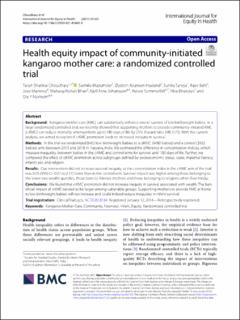| dc.contributor.author | Choudhary, Tarun Shankar | |
| dc.contributor.author | Mazumder, Sarmila | |
| dc.contributor.author | Haaland, Øystein Ariansen | |
| dc.contributor.author | Taneja, Sunita | |
| dc.contributor.author | Bahl, Rajiv | |
| dc.contributor.author | Martines, Jose Carlos | |
| dc.contributor.author | Bhan, Maharaj Kishan | |
| dc.contributor.author | Johansson, Kjell Arne | |
| dc.contributor.author | Sommerfelt, Halvor | |
| dc.contributor.author | Bhandari, Nita | |
| dc.contributor.author | Norheim, Ole Frithjof | |
| dc.date.accessioned | 2022-01-28T09:09:22Z | |
| dc.date.available | 2022-01-28T09:09:22Z | |
| dc.date.created | 2022-01-11T08:24:53Z | |
| dc.date.issued | 2021 | |
| dc.identifier.issn | 1475-9276 | |
| dc.identifier.uri | https://hdl.handle.net/11250/2929940 | |
| dc.description.abstract | Background: Kangaroo mother care (KMC) can substantially enhance overall survival of low birthweight babies. In a large randomized controlled trial, we recently showed that supporting mothers to provide community initiated KMC (ciKMC) can reduce mortality among infants up to 180 days of life by 25% (hazard ratio (HR) 0.75). With the current analysis, we aimed to explore if ciKMC promotion leads to increased inequity in survival.
Methods: In the trial we randomized 8402 low birthweight babies to a ciKMC (4480 babies) and a control (3922 babies) arm, between 2015 and 2018 in Haryana, India. We estimated the difference in concentration indices, which measure inequality, between babies in the ciKMC and control arms for survival until 180 days of life. Further, we compared the effect of ciKMC promotion across subgroups defined by socioeconomic status, caste, maternal literacy, infant’s sex, and religion.
Results: Our intervention did not increase survival inequity, as the concentration index in the ciKMC arm of the trial was 0.05 (95% CI -0.07 to 0.17) lower than in the control arm. Survival impact was higher among those belonging to the lower two wealth quintiles, those born to illiterate mothers and those belonging to religions other than Hindu.
Conclusions: We found that ciKMC promotion did not increase inequity in survival associated with wealth. The beneficial impact of ciKMC tended to be larger among vulnerable groups. Supporting mothers to provide KMC at home to low birthweight babies will not increase and could indeed reduce inequities in infant survival. | en_US |
| dc.language.iso | eng | en_US |
| dc.publisher | BMC | en_US |
| dc.rights | Navngivelse 4.0 Internasjonal | * |
| dc.rights.uri | http://creativecommons.org/licenses/by/4.0/deed.no | * |
| dc.title | Health equity impact of community-initiated kangaroo mother care: a randomized controlled trial | en_US |
| dc.type | Journal article | en_US |
| dc.type | Peer reviewed | en_US |
| dc.description.version | publishedVersion | en_US |
| dc.rights.holder | Copyright The Author(s) 2021 | en_US |
| dc.source.articlenumber | 263 | en_US |
| cristin.ispublished | true | |
| cristin.fulltext | original | |
| cristin.qualitycode | 1 | |
| dc.identifier.doi | 10.1186/s12939-021-01605-0 | |
| dc.identifier.cristin | 1976454 | |
| dc.source.journal | International Journal for Equity in Health | en_US |
| dc.relation.project | Universitetet i Bergen: - | en_US |
| dc.relation.project | Norges forskningsråd: 223269 | en_US |
| dc.identifier.citation | International Journal for Equity in Health. 2021, 20, 263. | en_US |
| dc.source.volume | 20 | en_US |

